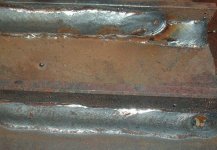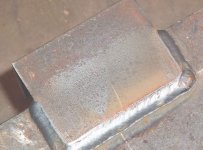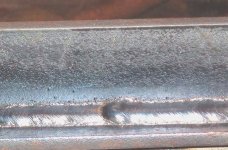You are using an out of date browser. It may not display this or other websites correctly.
You should upgrade or use an alternative browser.
You should upgrade or use an alternative browser.
Welder/Plasma supply wireing, need homework graded
- Thread starter Western
- Start date
- Views: 10876
/ Welder/Plasma supply wireing, need homework graded
#11
Sberry
Platinum Member
(removed) might know a bit more about the older ones than I do as I was kind of a late cummer to the wire world. I barely fumbled around on them as I worked about the first 10 yrs Ironwork and only really got on to them in my carousing days when I started slumming around smaller job shops. I was skeptical but I soon learn the gap filling potential and I have always kind of understood fusion, I get it we sposed to melt it in and not lay it on top. If I was really welding more would go to Co2 for cost and a bit of dig,,,, I wanna add that while it crossed my mind but I see guys from welding school can never seem to get a stick bead not to roll on, obvious as daylight but not everyone see it.
Anyway I can be a good welder, after running 6010 and really 7018 for a decade the wire was on roids to the max. Same for Innershield. I was almost good enuf on sticks, it looked good to everyone but me but the wire is the bomb.
A welding regret I have is never pipelining. It seems everytime I got the notion something jumped up. I still really dont like rolling around in the dirt and barely tolerate much grease which I have somewhat concurred with hot wash but the mud, yuk, all cold and dreary in a ditch. Iron is a lot that way too, cold bitter winter and I should have absconded to someplace about 4 months to some competitive work. That JT on the forums eludes to this.
Reason I mention it was a minute remis about the learning curve. That 185 would be a nascar building machine.
Anyway I can be a good welder, after running 6010 and really 7018 for a decade the wire was on roids to the max. Same for Innershield. I was almost good enuf on sticks, it looked good to everyone but me but the wire is the bomb.
A welding regret I have is never pipelining. It seems everytime I got the notion something jumped up. I still really dont like rolling around in the dirt and barely tolerate much grease which I have somewhat concurred with hot wash but the mud, yuk, all cold and dreary in a ditch. Iron is a lot that way too, cold bitter winter and I should have absconded to someplace about 4 months to some competitive work. That JT on the forums eludes to this.
Reason I mention it was a minute remis about the learning curve. That 185 would be a nascar building machine.
Attachments
Sberry
Platinum Member
Something didnt load with the 2nd pic above. The first pic is what you can do with the 185 and maybe a pinch more. This is short circu9it but note how close it is to turning in to something else in a sense that there is a total lack of a stack that there are no ripples. The 185 will do this as good as a crap 255 I got. I stop in the middle and tune a volt to try to get the spatter out.
Attachments
workinonit
Elite Member
That's a lot of typing there Sberry. Bottom line is per code you must size your conductors to amply carry that particular load. If in conduit it is de-rated. All I was saying when I replied is that I simply pulled one circuit large enough to run my largest machine which is my Syncrowave 200 and paralleled it to 4 Appleton 60 amp welding receptacles. I have the mating welding plugs on all of my machines and they stay plugged in all the time. I think I ran #4 AWG for the circuit and I have the breaker sized to protect the circuit. Since I am a one man show and I haven't figured out how to run multiple machines at the same time I think I'm good. Although with #4 I can if I want.
Sberry
Platinum Member
I agree that what you did was dandy. Its legal because you cant over load the conductors, 2 full loads would trip the breaker, same as 2 heaters on a 120v circuit might. But this leads a little to some of all that typing. Its obvious you understand the thermal dynamics of overheating this wire. However simply for lack of better wording that is kind of skin deep. When you are using 1 thing at a time the breaker is not protecting the wire, the fact that you have it connected to a load that wont overheat it is what protects the wire. Think about the 15A power strip plugged in to 20A outlet, the wire is ahead of the thermal, not behind it like a breaker.
So,,, the reason for this ramble is too fold,, I am guilty of doing things that "I do" or have done doesnt make it a proper install in regards to thse common welding machines.
So,,, the reason for this ramble is too fold,, I am guilty of doing things that "I do" or have done doesnt make it a proper install in regards to thse common welding machines.
Sberry
Platinum Member
I had a call. Let me look at a 200 again, its a tranny I believe, older one. They might have been 80 service. Ok, I miss something but think its 56A @ 40%,, anyway a number 8 machine and they allow a looooooong circuit. If I was wiring this for you in your shop would have ran a set of wires to 1 60A outlet just for this machine as it does not come cord and plug, says have a qualified electrical do it due to the nature it aint all done thru cord and plug. This machine with 8 or better can be connected to 80A and will overheat the machine before it overheats the wire and loss is proportional to distance.
Ideally this would be a single circuit in pipe just to this machine.
This is not a legal circuit for any other cord and plug machine for most practical purpose of this conversation and the only exception may be a 251.
50A cord and plug machines are limited to 50A breakers, there is an exception for derating the wire b8ut none for increasing the max breaker, they NEED to be on a current limjited circuit due to the fact the machine rellies on the circuit breaker for part and in some cases as an AC and AC/DC buzz box for all its short circuit protection!!!! The 12 wire in its cord is not adequate to hook to a 80A circuit.
Ideally this would be a single circuit in pipe just to this machine.
This is not a legal circuit for any other cord and plug machine for most practical purpose of this conversation and the only exception may be a 251.
50A cord and plug machines are limited to 50A breakers, there is an exception for derating the wire b8ut none for increasing the max breaker, they NEED to be on a current limjited circuit due to the fact the machine rellies on the circuit breaker for part and in some cases as an AC and AC/DC buzz box for all its short circuit protection!!!! The 12 wire in its cord is not adequate to hook to a 80A circuit.
Sberry
Platinum Member
The 180/190 class and many older small mig came with the same cord they use on a buzzer they pass 2x the current thru,,, ha Machine power supply only requires a 14 wire. They even spec a 12 ground though , something about the recept I spose. But being 240 only they simply use all 12 cord to meet 50A connection, went to 2 p switch followed by its own thermal. Connected to 50A with 12, wont overheat a 12 or larger circuit which is the thermal protection for the building wire. Machine will quit on its internal thermal well before overheating the cord in that case.
There should be 2 circuits, one for the synchro and one with a 50 on it to 6-50R.
There should be 2 circuits, one for the synchro and one with a 50 on it to 6-50R.
Sberry
Platinum Member
You can splice 2 number 10 to a 6 to a 50 breaker. the wire to each outlet only needs to serve its load. (welder circuit) Could run 2 200 class migs at a time from a 50 breaker, could run half a dozen limited to 2 at a time but alternate duty cycle as they will not overheat the 6 wire.
But the cord and recept system this is ALL based on says,,, its a 50A,,, its a 20 or a 30 and that means it has a breaker on it is the same. That is the "code". Its not even my opinion, its the legal way it is sposed to be wired to connect those machines to it..
But the cord and recept system this is ALL based on says,,, its a 50A,,, its a 20 or a 30 and that means it has a breaker on it is the same. That is the "code". Its not even my opinion, its the legal way it is sposed to be wired to connect those machines to it..
Sberry
Platinum Member
I use posts and just delete one by accident if I don't. I think the service guide shows direct wire for the 200. It would be good for a Dialarc class too. Your circuit is as good as I use on my 300 but I never really use it.
I weld from 10 wire, some from 50 and some from 30. But they are dedicated.
I weld from 10 wire, some from 50 and some from 30. But they are dedicated.
user.69169
Veteran Member
- Joined
- Feb 22, 2009
- Messages
- 1,306
You got what de book say, and you got de real world.
Book says 1 plug per circuit fer machine wiring, plug is only a safety disconnect from what I recall of de book.
Book also say service must be greater amperage den total amperage of every machine in shop, even in 1 man shop.
Den you got reality, book don't mean diddle unless local town declares de book to be de authority. More bullrap.
Real world, machine might be 400 amp capable but dat not mean machine ever gonna run 400. What machine sucks thru meter strictly determined by what machine outputting amps, NOT nameplate. Nameplate about as useful as de code book in real world.
Worst case, you live in house wid homeowner busybody club where you need written permission to pee on your grass, IF you kiss enough azz you get to have welding machine in your neighbor approved garage, you go by de book. You live in house long way to paid for and planning to move, go by de book. Probably best you remove all traces of shop before listing de house.
If you live in sane world, you go wid what works.
Wire size determined by 3 real facts.
Amp capacity is function of ability of insulation to handle heat and shed heat to surrounding. You can put 100 amps thru doorbell wire hanging between insulators on poles and it won't overheat. Fuse element proves dat all day every day.
Second big fact determining size of wire between machine and panel is real important. Gotta keep in mind inrush current when arc is struck, and long wire too thin won't accomodate 10 times actual weld current. Gonna give you lot of trouble establishing arc. Gonna give you low voltage at machine too, not good.
Remember in lab at factory where machine made, specs were made in a Lab where voltage to machine was adjustable to be maintained at 120 or 125 volts on nameplate. Put 100 feet of #14 cord between plug & machine and meter you probably see about 110 volts. Hurts performance and near kills arc start.
You running machine from plug in house, distance from plug to panel factors in too because dat Romex no different from extension cord so you probably below nameplate voltage at plug. Too big wire between panel and machine never been a problem, too small generally is.
All wire generates heat as electrons march along from panel to machine. 50 amps going thru # 10 copper makes more heat den 50 amps going thru #8 wire. Hear becomes more problem as time builds. Heat changes amp carry capacity of wire as wire gets hotter. Long enough time small wire becomes smaller electrically. NOT GOOD..
Aluminum wire adds whole extra set of problems. Generally you gonna be seeing aluminum over #10 size wire.
SO, since you 1 man using 1 machine at a time, and really don't want de cost of 1 plug + wire + breaker for every machine, how you do it cost effective?
Simple. Code provides completely legal workaround, same thing you see at every festival you trip over cords and walk around splitter boxes where cords meet up. No different from plugstrip behind computer.
Code says code doesn't apply beyond plug connected forever to panel.
Get yourself 6 foot range cord, make metal box wid 4 range plugs, wire it up and you got breakout box. Add couple breakers if you want or even fuses and you can add 120 volt plugs to welder strip too. Plasma machine real good for cutting outlet openings.
Smart move when building, add pair of 120 volt indicator lights to welder strip.
Book says 1 plug per circuit fer machine wiring, plug is only a safety disconnect from what I recall of de book.
Book also say service must be greater amperage den total amperage of every machine in shop, even in 1 man shop.
Den you got reality, book don't mean diddle unless local town declares de book to be de authority. More bullrap.
Real world, machine might be 400 amp capable but dat not mean machine ever gonna run 400. What machine sucks thru meter strictly determined by what machine outputting amps, NOT nameplate. Nameplate about as useful as de code book in real world.
Worst case, you live in house wid homeowner busybody club where you need written permission to pee on your grass, IF you kiss enough azz you get to have welding machine in your neighbor approved garage, you go by de book. You live in house long way to paid for and planning to move, go by de book. Probably best you remove all traces of shop before listing de house.
If you live in sane world, you go wid what works.
Wire size determined by 3 real facts.
Amp capacity is function of ability of insulation to handle heat and shed heat to surrounding. You can put 100 amps thru doorbell wire hanging between insulators on poles and it won't overheat. Fuse element proves dat all day every day.
Second big fact determining size of wire between machine and panel is real important. Gotta keep in mind inrush current when arc is struck, and long wire too thin won't accomodate 10 times actual weld current. Gonna give you lot of trouble establishing arc. Gonna give you low voltage at machine too, not good.
Remember in lab at factory where machine made, specs were made in a Lab where voltage to machine was adjustable to be maintained at 120 or 125 volts on nameplate. Put 100 feet of #14 cord between plug & machine and meter you probably see about 110 volts. Hurts performance and near kills arc start.
You running machine from plug in house, distance from plug to panel factors in too because dat Romex no different from extension cord so you probably below nameplate voltage at plug. Too big wire between panel and machine never been a problem, too small generally is.
All wire generates heat as electrons march along from panel to machine. 50 amps going thru # 10 copper makes more heat den 50 amps going thru #8 wire. Hear becomes more problem as time builds. Heat changes amp carry capacity of wire as wire gets hotter. Long enough time small wire becomes smaller electrically. NOT GOOD..
Aluminum wire adds whole extra set of problems. Generally you gonna be seeing aluminum over #10 size wire.
SO, since you 1 man using 1 machine at a time, and really don't want de cost of 1 plug + wire + breaker for every machine, how you do it cost effective?
Simple. Code provides completely legal workaround, same thing you see at every festival you trip over cords and walk around splitter boxes where cords meet up. No different from plugstrip behind computer.
Code says code doesn't apply beyond plug connected forever to panel.
Get yourself 6 foot range cord, make metal box wid 4 range plugs, wire it up and you got breakout box. Add couple breakers if you want or even fuses and you can add 120 volt plugs to welder strip too. Plasma machine real good for cutting outlet openings.
Smart move when building, add pair of 120 volt indicator lights to welder strip.



